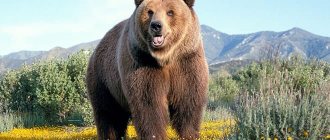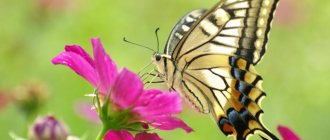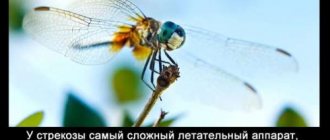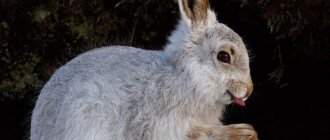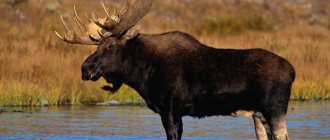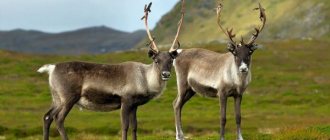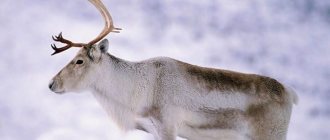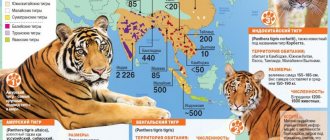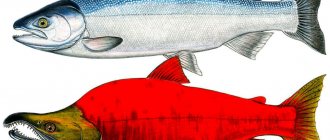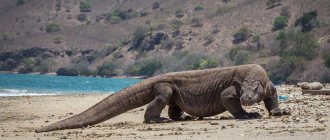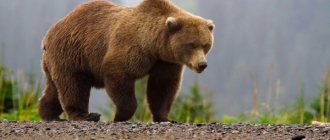Reindeer are very beautiful and stately animals. They have many “superpowers” that allow them to survive in the Far North. Most people don't even know about some of them. Few people know what a female deer is called. Let's not waste time and tell you everything in order.
Before we find out what a female reindeer is called, let's talk a little about this species.
Description of reindeer
The height of the reindeer at the withers is about 1.5 m, the body is oblong, its length is about 220 cm. The weight of the animals is from 100 to 220 kg.
Females are always smaller than males. — Advertising —
The color of the fur of reindeer is very diverse, and includes many shades of brown and brown. The inhabitants of forest zones are painted in the darkest tones; specimens that live on islands are usually lighter. In winter, the animal’s fur changes color, it becomes much lighter, and there are individuals of a beautiful ash color. The coloring of male and female reindeer is the same. During molting, the summer coat, which reaches 1 cm in length, is replaced by winter coat, which is very long and thick. The structure of the fur allows this animal to withstand fairly low temperatures and also to swim.
Besides the fur, the structure of the reindeer's hooves is unusual. The hooves are wide, helping to stay on the surface of the snow; between them there are long hairs that perform the same function. The shape of the hooves is concave, making it convenient to dig with them and the animal can get food from under the snow.
Of course, the main pride and dignity of a reindeer are its antlers. Both males and females of this species have them. But the former have more luxurious horns, they are very branched and long. For the winter, males shed their antlers, and females become hornless only after giving birth.
Appearance and features
Photo: Red deer Red Book
It’s not for nothing that red deer are called “kings of the forest.” This is a rather large and strong animal. The size of an adult male is from 170 to 210 cm in length, the height of the animal at the withers is 127-148 cm. An adult male animal weighs 174 -209 kg. Females of this breed are significantly smaller than males. The average adult female deer weighs from 130 to 162 kg. The length of the body is from 160 to 200 cm. The height of an adult female is 110-130 cm. Two-year-old young animals weigh approximately 120 kg. Adults of this species weigh on average 170 kg.
Molting in red deer occurs in spring and autumn. Spring molt occurs from late April to early June. Coat renewal in autumn occurs in September-October, depending on the climate in which the animal lives.
Video: Red deer
The average life expectancy in natural conditions is about 17-18 years. In captivity, animals live a little longer, about 24 years. An adult deer has 34 teeth in its mouth. Of these, 20 teeth are located on the lower jaw and 14 on the upper jaw. A complete set of teeth and jaw formation occurs at 24 months of the animal’s life.
Deer's fur is thick and its color can vary. Deer have hollow hairs on their skin that protect the animal’s body from the cold and prevent it from freezing even in extremely cold conditions. There are many blood capillaries on the deer’s legs, so no matter how sparsely covered they are, they don’t freeze. Reindeer can withstand temperatures down to minus 60 degrees Celsius.
Dietary features of reindeer
Reindeer is a herbivore. He is able to feed on almost all the plants that only he can find in the harsh conditions of his habitat. The basis of the animal’s diet is moss, a lichen that grows in the northern regions. Since reindeer moss contains insufficient amounts of vitamins, reindeer also eat berries, mushrooms, various herbs, and even cereals, everything that it finds in the summer. Reindeer especially love cereal plants. For example, domesticated reindeer are mainly fed silage and hay.
Origin of the species and description
Photo: Red deer
The deer family Cervldae has a huge number of breeds. Red deer, sika deer, flower deer, wapiti deer, large marl deer, Bukhara deer.
One of the first representatives of this species is the giant deer (Megaceros); this species is also called the big-horned deer. This species lived from the Pliocene to the Polyanite. This is about a million years ago. The ancestors of modern deer lived in central Asia. From there they spread throughout the world.
During evolution, several subgroups appeared - Western-type deer. In this species, the horns grew in the form of a crown. The red deer is precisely a modern representative of this type. And the eastern type of individual, their horns do not branch. Representatives of this genus in the form in which we are accustomed to seeing it appeared in the Paleolithic. Since then, in fact, the appearance of the animal has not changed much.
Distribution of reindeer
— Advertising —
According to their habitats, reindeer are classified into tundra, forest and mountain reindeer. These names correspond to where this or that population lives. Tundra deer live in the tundra, forest deer prefer forests to live, and mountain deer are found in the mountains. This division is rather arbitrary, since this species is prone to frequent migrations and constantly changes its places of residence.
The reindeer's habitat includes North America, Russia, Kamchatka, northern Canada, Alaska, Sakhalin and Taimyr. This is why this species of deer received the name northern, since it primarily lives in the harsh northern climate.
Habitats
Reindeer can be found in the tundra, taiga and forest-tundra, in areas richest in vegetation. Animals can live in mountainous, flat and even swampy areas. The favorite places of deer are the banks of lakes and rivers, where the grass is especially lush and where there is water.
To be more specific, deer live in the following areas:
- mountainous regions of Norway;
- northern part of Russia;
- USA (Alaska);
- Canada.
In Sweden and Finland today only domestic reindeer live.
Reindeer behavior
In summer, reindeer live on the Arctic coasts.
During this period, in any other areas they are attacked by clouds of midges, and only cool arctic winds prevent the midges from bothering the animal. After the onset of cold weather, reindeer form herds and move into the forests. When migrating, animals look for areas where there is not a lot of snow, since from under large snowdrifts they simply will not be able to get their food. Migrations stretch over 500 km, while deer swim across rivers and overcome other obstacles in search of places suitable for their life. When May arrives, the herds head back to the tundra. It is interesting that the movements of groups of reindeer always take the same road.
Reindeer usually live in herds. Sometimes single individuals are found, but in general this is very rare for this species. The number of animals in a group is variable. Usually there is one male, and females with young animals.
A dominant male protects his herd, both from other males and from predators. He marks the territory of his group with a special secret and drives away all strangers and strangers from it.
Where do red deer live?
Photo: Caucasian red deer
The habitat of red deer is huge. Deer live virtually all over the world. In Russia, these are the forests of the central part of the country, Kaluga and Bryansk regions. North, Yakutia and the entire Sokha Republic. Kolyma and Kamchatka. Ukraine and Belarus, the Baltic states.
Abroad, these are Algeria, Morocco, Chile, North Africa, Argentina. Deer also love the lush grasslands of New Zealand. A large number of deer of this breed live in Alaska and North America. This species easily tolerates acclimatization. And therefore it occupies vast territories around the world.
The red deer lives in mixed forests with mostly deciduous trees. Deer are herbivores; they feed on plant foods, so they live mainly where this food can be obtained. In 1781, domestication of this type of animal also began in Russia.
Reindeer breeding
The mating season for reindeer begins in mid-October and lasts until the end of November.
At this time, males behave especially aggressively and often engage in real fights with each other. The strongest male wins the right to mate with 10 or more females during the rutting period. Pregnancy lasts about 8 months, the offspring are born in late spring or early summer. Typically, a female reindeer has one baby per litter. Twins are born very rarely.
A newborn fawn is very small and weak, its weight barely reaches 6 kg, but a few days after birth it already begins to develop horns. In general, the fawn grows and gains weight quite quickly, since soon after its birth the migration period begins, which involves covering quite significant distances. Adult males closely monitor their herds, protect them from predators, and in case of attacks they even engage in battles with the latter in order to protect their females and offspring
A newborn fawn stays with its mother for the first two years of life, until puberty. The lifespan of a reindeer is about 25 years.
Female deer and her cubs
The cubs are carried in the womb for eight months. In most cases, only one fawn is born; very rarely there are twins.
Newborn cubs lie down under their mother's side for the first day, and on the second they already follow their parent, not lagging behind even a step. On the twentieth day of life, babies' horns already begin to grow. The fawn feeds on its mother's milk until the beginning of winter.
Natural enemies of reindeer
Reindeer are most vulnerable during their migrations, when even adult individuals are attacked by predators such as wolves, wolverines, lynxes and others. But the greatest harm to the population of this animal is caused by people, namely, uncontrolled hunting and poaching for the purpose of obtaining antlers (young horns).
Features of character and lifestyle
Photo: Red deer in Russia
The character, habits of an animal and lifestyle mainly depend on where the animal lives. Wild animals are aggressive and fearful. They need to protect themselves and the herd from predators and survive in an aggressive natural environment. During the migration of deer, hearing the roar of the leader, it is better for people to leave. Deer do not attack people, however, they are not afraid to defend themselves.
In the wild, male deer can live alone, while females gather in small herds. Herds of females are 4-7 individuals. Sometimes small herds of one male and several females with cubs gather. The main differences between females and males appear during the mating season. During the mating season, males become aggressive. They forget about food and food and look for a female. At this time, a deer can kill with its antlers not only another male, but also a female who does not reciprocate.
Also, male deer, either in a fit of rage, or in order to free themselves from heavy antlers, forcefully hit the trees with their antlers. At the same time, the wild knocking and roar of males can be heard through the forest.
This occurs during the winter; males are often completely exhausted during the mating season and many do not survive the winter. Much of the life of deer, like other animals, is spent in search of food. When in special need, deer may come to people's houses in search of food.
Red deer interact well with humans. In the North of our country and in other countries, reindeer husbandry is widely developed. Man was able not only to tame this animal, but also to make the deer a good helper. Reindeer transport loads and work harmoniously in teams. On the farm, red deer are kept in small herds. The deer on the farm live on free grazing; they need large territories.
Deer have a very developed collective migration instinct, to the point that domestic reindeer migrate, although over time this instinct becomes dulled. Deer are raised both for economic purposes and for meat. Venison is a staple food for residents of the north and Far East.
Interesting facts about reindeer
- Antlers or unossified deer antlers have medicinal properties and are widely used in both folk and official medicine. An extract is isolated from them, which has general tonic and adaptogenic properties. Professor I. I. Brekhman in the middle of the last century developed a medicinal preparation from reindeer antlers, tablets called “Rantarine”, and a liquid product “Velcornin”. The drug "Epsorin" was the first high-quality extract obtained from the antlers of wild reindeer. The ossified horns of this animal species are used to make the food supplement “Tsigapan”, which is endowed with immunostimulating properties.
Population and species status
Photo: Red deer Russia
The status of the species Red deer in the Red Book is “species with reduced vulnerability.” Deer hunting is not permitted in all areas or at certain times of the year. The red deer population has been declining significantly in the last decade, so deer hunting is only permitted for a few months of the year. This is mainly the autumn-winter period.
Previously, in the cities of Yakutia in the north and Taimyr there was a high population of deer, which created a threat to people's lives. Deer approached populated areas; in winter, wild deer posed a danger to humans. In addition, deer ate some types of plants that could not recover.
Over time, the deer population has decreased greatly, so certain restrictions have been introduced on hunting. And for economic purposes and food consumption, a commercial farm has been organized where deer are bred for human needs.
Deer engage in fierce fights
Photo: Edward Taylor
The fight begins when a contender for the female appears. The stranger and the harem owner growl at each other. After a few minutes of roaring, they begin to move parallel to each other, tense and wary, until one of them turns to the other and lowers its horns. The males lock horns and begin to push each other. When one manages to push the other away, the losing opponent runs away.
Fights are very dangerous. Nearly a quarter of the males in the Scottish study were injured during the rut, with 6% dying. A male aged 7-10 years has the best chance of winning such a fight, which the harem owner faces approximately five times during the mating season. In addition to injury, there is another danger to the harem owner: young males often hide on the outskirts of the harem, waiting for the harem owner to be distracted, and then "kidnap" one or two females. The apparent benefits of having a harem are deceptive; although there may be up to 20 females in a harem, a male may father only four or five fawns.
Deer are ruminants with a four-chambered stomach.
When food is swallowed, it enters the first chamber, the rumen, where bacteria begin to break it down. Later, the deer regurgitates the food back into its mouth and, like cud, chews it again and mixes it with saliva. When swallowed again, food bypasses the rumen and enters the second chamber of the stomach, the reticulum, and then passes into the third chamber, the abomasum, and later enters the fourth chamber, the abomasum. The food then moves to the small intestine where nutrients are absorbed. Although this entire process takes about 80 hours, it converts about 60% of the cellulose found in food into healthy sugars and is thus extremely effective.
Photo: Ethan Garvey
Did you know?
- The deer family includes 51 species, which are divided into 19 genera and 3 subfamilies: water deer (Hydropotinae), Eurasian deer (Cervinae) and roe deer (Capreolinae).
- The smallest deer species is the Pudu, growing to 25-43 cm at the shoulder and weighing 6-10 kg. The largest species is the European moose, whose height at the shoulder reaches 140-235 cm and weight 200-600 kg.
- Some deer species, such as water deer, muntjac deer, and tufted deer, have protruding canines. In other species, the upper canines are either vestigial or absent. Toothed deer are considered to be more ancient in evolutionary terms than deer with antlers because tusks are characteristic of primitive fawns, or mouse deer. Later species of deer are thought to have large bodies, large and complex antlers, and a more herd social system.
- Females of tropical deer species come into heat several times a year. Pregnancy lasts from 176 days in water deer to 294 days in roe deer. A female deer gives birth to one to six fawns, but one or two fawns is the norm. Most deer babies are born spotted.
- White-tailed deer may be the most abundant species of wild large mammal, with a population of approximately 60 million individuals.
Deer run fast
Photo: Hari Nandakumar
Deer's legs are long and thin, well adapted for fast running, which allows him to escape from numerous predators. Over the course of evolution, deer leg bones became longer and the animal's weight was supported entirely by the third and fourth toes, eventually leading to the development of cloven hooves. The second and fifth fingers are short and pointing upward. The first finger has disappeared, and the bones of the palm (metacarpal and metatarsal bones) are connected into a single bone - the tibia. Similar evolutionary changes occurred in other herbivores, which were often forced to flee from predators.
Shape and size of horns
However, the males of other species of the deer family are entirely horned. Although not everyone's horns are as luxurious as we usually imagine. The same pudu or another fanged deer - muntjac - have very small horns, for example. of a roe deer , are also small .
Muntjac (photo: Biswarup Ganguly, wikipedia.org) and roe deer (photo: Przykuta, wikipedia.org)
Another thing is the red deer , on each of which you can count at least five shoots. By the way, if you hear such names as wapiti, red deer, wapiti, you should know that these are all subspecies of red deer...
A very beautiful crown is worn by the deer of Southeast Asia - the barasinga (its antlers are gracefully and widely spread to the sides) and the lyre deer (the name speaks for itself).
Barasinga (photo: Prajwalkm, wikipedia.org) and lyre deer (photo: Hans Hillewaert, wikipedia.org)
The Chinese David's (or milu ) deer's antlers are sometimes laid back so far that they appear to have been attached backwards. By the way, this is not the only feature of this species. As I already mentioned, the tails of deer are usually short (in roe deer, for example, it is almost invisible from the fur). But David’s deer’s tail reaches 50 cm - and this is a record among the family.
David's Deer Photo: DiverDave, wikipedia.org
Also, the existence of this species is one of the strongest arguments in favor of zoos. The fact is that by the 19th century, almost all David's deer had disappeared from the wild. Only a small herd remains in the Chinese Emperor's Park. True, in 1895, during the Yellow River flood, the wall of the park collapsed, the deer escaped into the wild and were soon safely killed. Fortunately, a few years earlier, several specimens had been donated to European zoos. There, David's deer began to reproduce successfully, which saved the species from complete extinction...
But let's get back to the horns. If we talk about their size, the most impressive are the antlers of reindeer, fallow deer and elk. In the last two species, they have the shape of a flattened shovel with processes, which slightly resemble an oak leaf. And the record holder (not only among deer, but also among all mammals) is the elk, whose antlers reach almost two meters in span and weigh up to 30 kg.
But today he is the record holder. And some 11 thousand years ago, during the Ice Age, a much more outstanding cuckold grazed in the steppes of Eurasia. In Latin it is called megaloceros , in our country - big-horned deer, and in the West - Irish peaty elk. Indeed, the best preserved remains of this species were found in the peat bogs of Ireland (former bogs where unfortunate animals regularly drowned).
And even though Megaloceros was even a little smaller in size than the modern elk, it had one and a half to two times more horns (span - 3.65 m, weight - 40 kg). Just imagine the horns, which make up 10% of the animal’s total mass! As if my head wouldn’t fall off during the race...
Megaloceros drowns in a swamp Photo: drawing by Z. Burian from the book “The Vanished World” by J. Augusta
It is also striking that Megaloceros (unlike its relatives, who prefer woody vegetation) fed exclusively on herbs. It is believed that it was the encroachment of forests on the northern steppes, which began after climate warming, that led to the extinction of this species. Apparently, the last representatives of Megaloceros became extinct in Siberia ca. 9 thousand years ago. It is known that Peter I presented the horns of one such Siberian specimen as a gift to the Saxon king Augustus the Strong.
Megaloceros skeleton Photo: Sterilgutassistentin, wikipedia.org
What is the name of a female giraffe?
Names of baby animals
| Parents | Cub (child) singular | |
| Father (male) | Mother (female) | |
| Walrus | Walrus | Walrus |
| Giraffe | Giraffe, in colloquial speech there is a name - giraffe. | A calf is the name given to all young artiodactyl animals, but there is also a baby giraffe. |
| Elk | Moose | Elk calf |
Bottom line
In conclusion, it should be noted that the reproduction of such animals includes a number of features. For example, in deer, the birth rate of males is much higher than that of females. This is due to the fact that they live less than females. Also in nature, they die more often due to clashes with predators, which is why they are born in greater numbers.
During the rutting period, males become very exhausted, since they hardly eat, but move around a lot. Because of this, only the strongest individuals remain in winter.
Share
